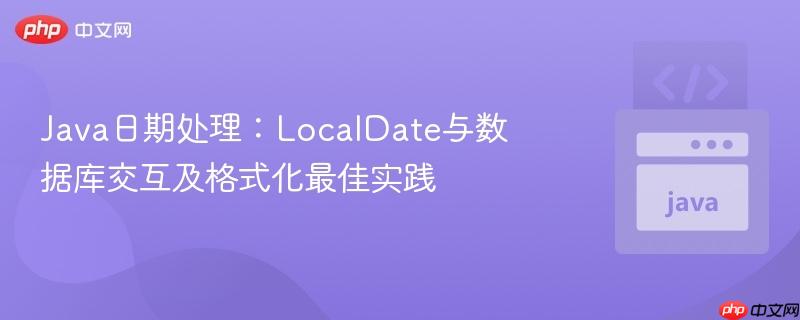
本文深入探讨了在Java中处理日期时,如何正确使用`java.time.LocalDate`与`java.sql.Date`进行转换、如何将`LocalDate`高效且安全地存储到数据库,以及如何对`LocalDate`进行灵活的格式化。文章强调了优先使用现代`java.time` API的优势,并提供了具体的代码示例和实践建议,帮助开发者避免常见陷阱。
在Java 8及更高版本中,java.sql.Date类引入了重载的valueOf方法,使其可以直接接受java.time.LocalDate作为参数,从而方便地将现代日期API类型转换为传统的SQL日期类型。
import java.time.LocalDate;
import java.sql.Date;
public class DateConversionExample {
public static void main(String[] args) {
LocalDate releaseDate = LocalDate.of(2023, 1, 23);
// 在Java 8+中,此行代码应正常工作
Date sqlDate = Date.valueOf(releaseDate);
System.out.println("LocalDate: " + releaseDate);
System.out.println("java.sql.Date: " + sqlDate);
}
}如果开发者在Java 8+环境中遇到类似'valueOf(java.lang.String)' in 'java.sql.Date' cannot be applied to '(java.time.LocalDate)'的错误,这通常不是代码逻辑问题,而更可能是集成开发环境(IDE)或项目构建配置导致的。IDE有时会出现缓存混乱或识别错误的情况。
排查建议:
立即学习“Java免费学习笔记(深入)”;
在将日期数据传递给数据库时,推荐的做法是直接使用java.time.LocalDate,而不是传统的java.sql.Date。从JDBC 4.2规范开始,JDBC驱动程序被要求支持java.time包中的日期时间类型。
为什么推荐 LocalDate?
将 LocalDate 写入数据库: 使用PreparedStatement的setObject方法可以直接传递LocalDate对象。
import java.sql.Connection;
import java.sql.PreparedStatement;
import java.sql.SQLException;
import java.time.LocalDate;
public class DatabaseWriteExample {
public void insertReleaseDate(Connection conn, LocalDate releaseDate) throws SQLException {
String sql = "INSERT INTO my_table (release_date) VALUES (?)";
try (PreparedStatement pstmt = conn.prepareStatement(sql)) {
pstmt.setObject(1, releaseDate); // 直接设置LocalDate对象
pstmt.executeUpdate();
System.out.println("LocalDate inserted successfully.");
}
}
}从数据库读取 LocalDate: 使用ResultSet的getObject方法并指定LocalDate.class作为目标类型。
import java.sql.Connection;
import java.sql.PreparedStatement;
import java.sql.ResultSet;
import java.sql.SQLException;
import java.time.LocalDate;
public class DatabaseReadExample {
public LocalDate getReleaseDate(Connection conn, int id) throws SQLException {
String sql = "SELECT release_date FROM my_table WHERE id = ?";
try (PreparedStatement pstmt = conn.prepareStatement(sql)) {
pstmt.setInt(1, id);
try (ResultSet rs = pstmt.executeQuery()) {
if (rs.next()) {
return rs.getObject("release_date", LocalDate.class); // 直接获取LocalDate
}
}
}
return null;
}
}处理遗留 java.sql.Date 对象: 如果不得不与返回java.sql.Date的遗留代码或API交互,应立即将其转换为LocalDate。
import java.sql.Date;
import java.time.LocalDate;
public class LegacyConversionExample {
public static void main(String[] args) {
Date legacySqlDate = Date.valueOf("2023-03-15"); // 假设这是从遗留API获取的
LocalDate localDate = legacySqlDate.toLocalDate(); // 转换为LocalDate
System.out.println("Legacy java.sql.Date: " + legacySqlDate);
System.out.println("Converted LocalDate: " + localDate);
}
}注意事项:
java.time.LocalDate本身不包含格式信息,当需要将其展示给用户时,通常需要将其格式化为特定的字符串。java.time.format.DateTimeFormatter是实现这一目标的核心工具。
自定义格式化: 可以使用模式字符串(如yyyy-MM-dd,MMM表示月份缩写)来定义日期格式。
import java.time.LocalDate;
import java.time.format.DateTimeFormatter;
public class CustomFormattingExample {
public static void main(String[] args) {
LocalDate date = LocalDate.of(2023, 10, 26);
// 格式化为 "2023-10-26"
DateTimeFormatter formatter1 = DateTimeFormatter.ofPattern("yyyy-MM-dd");
String formattedDate1 = date.format(formatter1);
System.out.println("Custom format (yyyy-MM-dd): " + formattedDate1);
// 格式化月份为MMM (例如:Oct)
DateTimeFormatter formatter2 = DateTimeFormatter.ofPattern("MMM dd, yyyy");
String formattedDate2 = date.format(formatter2);
System.out.println("Custom format (MMM dd, yyyy): " + formattedDate2);
// 格式化月份为MMMM (例如:October)
DateTimeFormatter formatter3 = DateTimeFormatter.ofPattern("MMMM dd, yyyy");
String formattedDate3 = date.format(formatter3);
System.out.println("Custom format (MMMM dd, yyyy): " + formattedDate3);
}
}本地化格式化: 为了更好地适应不同地区的用户习惯,DateTimeFormatter支持基于Locale的本地化格式。FormatStyle枚举提供了预定义的格式样式(如LONG, MEDIUM, SHORT)。
import java.time.LocalDate;
import java.time.format.DateTimeFormatter;
import java.time.format.FormatStyle;
import java.util.Locale;
public class LocalizedFormattingExample {
public static void main(String[] args) {
LocalDate date = LocalDate.of(2023, 10, 26);
// 英国本地化长格式 (例如:26 October 2023)
Locale localeUK = Locale.UK;
DateTimeFormatter formatterUK = DateTimeFormatter.ofLocalizedDate(FormatStyle.LONG)
.withLocale(localeUK);
String outputUK = date.format(formatterUK);
System.out.println("Localized (UK, LONG): " + outputUK);
// 美国本地化长格式 (例如:October 26, 2023)
Locale localeUS = Locale.US;
DateTimeFormatter formatterUS = DateTimeFormatter.ofLocalizedDate(FormatStyle.LONG)
.withLocale(localeUS);
String outputUS = date.format(formatterUS);
System.out.println("Localized (US, LONG): " + outputUS);
// 中国本地化中等格式 (例如:2023年10月26日)
Locale localeCN = Locale.CHINA;
DateTimeFormatter formatterCN = DateTimeFormatter.ofLocalizedDate(FormatStyle.MEDIUM)
.withLocale(localeCN);
String outputCN = date.format(formatterCN);
System.out.println("Localized (CN, MEDIUM): " + outputCN);
}
}通过结合DateTimeFormatter的自定义模式和本地化功能,开发者可以灵活地将LocalDate对象格式化为满足各种显示需求的字符串。
现代Java应用程序应优先采用java.time包中的日期时间API,尤其是LocalDate,来处理日期相关的业务逻辑和数据存储。java.time.LocalDate提供了更清晰、更准确的日期模型,并与JDBC 4.2+驱动程序无缝集成,简化了与数据库的交互。对于日期显示,DateTimeFormatter提供了强大的格式化和本地化功能,确保日期信息能够以用户友好的方式呈现。通过遵循这些最佳实践,开发者可以构建出更健壮、更易于维护的日期处理系统。
以上就是Java日期处理:LocalDate与数据库交互及格式化最佳实践的详细内容,更多请关注php中文网其它相关文章!

每个人都需要一台速度更快、更稳定的 PC。随着时间的推移,垃圾文件、旧注册表数据和不必要的后台进程会占用资源并降低性能。幸运的是,许多工具可以让 Windows 保持平稳运行。

Copyright 2014-2025 https://www.php.cn/ All Rights Reserved | php.cn | 湘ICP备2023035733号